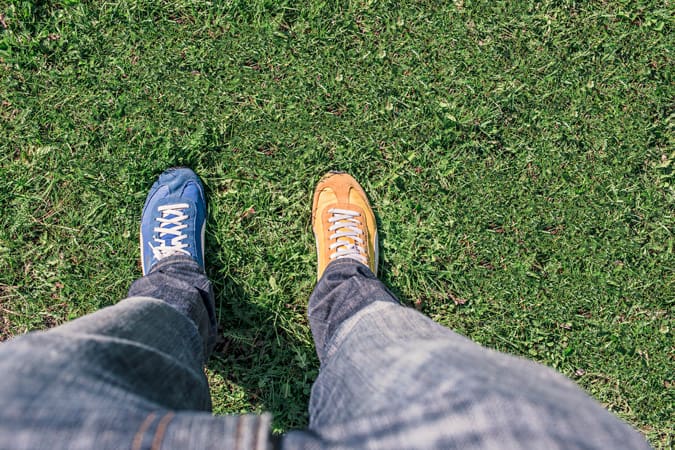How Hypnosis Impacts Your Brain
Reading time: 10 minutes 1 second
In 1997, I stood in front of five hundred people in a crowded canteen in the center of my college campus. I was doing a stage hypnosis show.
In the weeks leading up to it, the student president mocked the show and organized a ‘real hypnotist’ for that evening. Now, at 4 pm on a Thursday, I was about to speak to the majority of students in my small college. The pressure was insane. I had to deliver.
At the time, besides debating contests, I had very little practice in public speaking. I had a stage brought in. Lights. And my friend was my DJ. My job was to entertain the audience. It was to hypnotize at least some people and create a two-hour fun-filled show for everyone.
I expect few people in the audience believed in hypnosis. Out of those that did, I’m also sure there were quite a number that believed it was dangerous. Two ideas that don’t work together very well.
I was obsessed with hypnosis having first picked up a book on it five or six years earlier. I became a qualified hypnotherapist just before my 17th birthday.
Nowadays, hypnosis has plenty more scientific background. But back then… not so much. Back then, it was seen as con artistry or a magician’s tool to trick the audience. I felt a responsibility not just to entertain but to educate. I took a deep breath and the song I elected to walk on stage to, ‘Insomnia’ by Faithless blared. This was it.
The two questions I always get asked on hypnosis
I rarely talk about hypnosis in much depth these days but when people hear that I have been a qualified hypnotist for over thirty years, they usually have the same questions:
- Does it really work?
- How and why does it work?
Let’s tackle these questions and, by doing so, let’s explore the various theories that try to explain the phenomenon. I also want to get into what is going on in the brain when we are hypnotized.
We’ll start with a history lesson.
The history of hypnosis
Two hundred and ten years before I stepped onto that stage, Louis XVI the King of France, commissioned a scientific investigation into a practice that had been gaining significant ground in the press at the time: Mesmerism.
Mesmerism involved patients sitting in a circle, holding hands, and touching rods connected to a bowl (known as a baquet) filled with iron filings and water.
Franz Anton Mesmer, a charismatic physician, would move around the room, touching the patients with a wand or his hands, believing he was channeling this magnetic fluid into their bodies to cure them.
Mesmer originally learned to do this from studying with Father Maximilian Hell, a Jesuit astronomer who used magnets for healing. While Hell believed that the magnets had healing properties, Mesmer suggested that they were actively influencing the flow of a ‘universal fluid’ that flowed in every human being. The process occurred through a force he described as animal magnetism.
Louis XVI’s crack team of experts (including Benjamin Franklin) concluded that Mesmer’s theory was not what was going on at all. Instead, the success of Mesmer seemed to have come about as a result of the power of suggestion.
In the middle of the nineteenth century, a Scottish surgeon, James Braid, became fascinated with the success of a traveling mesmerist and decided to explore it further.
He described his understanding of what was going on as ‘Neurohypnotism’ or ‘Hypnosis’. It was a psychological phenomenon that was made possible by creating a state of focused attention. This led to heightened suggestibility and promoted vivid imagination.
Nowadays hypnosis is practiced across the world. The greatest hypnotists of the twentieth century: Erickson, Boyne, Ellman, and Bandler all with their own style of using hypnosis to bring about change in those they worked with.
Of course, the very same strategies have been used by governments, cults, gurus, shamans, and special agencies throughout history to influence large groups of people. But let’s look at the answer to:
Does hypnosis really work?
I’m going to spend little time on this. If you think about the subtext to this question, you are effectively saying.
“Owen, you’ve been doing hypnosis for 30 years. Are you a con artist?”
“No. No, I’m not. Hypnosis works.”
I’ve used hypnosis on myself and tens of thousands of people over the years. I used to take bets from other students who believed they couldn’t be hypnotized. I never lost.
It’s legit. There are plenty of research studies to back it up.
Indeed, I did a research study at university twenty-five years ago and it was overwhelmingly positive in supporting the use of hypnosis as a viable clinical tool. Now, there are thousands of studies backing it up.
How and why does it work?
This is a much more interesting question. Let’s start with Mesmer and work our way up to our current understanding. Mesmer thought we all have a universal fluid inside of us and the magnets he used could influence the liquid and heal us.
Braid concluded the phenomenon was psychological and made possible by enhanced suggestibility.
The general process involved is that hypnosis focuses attention and makes people more susceptible to suggestion.
In the twentieth century, several key theories emerged as to what goes on when hypnosis is happening.
The Altered state of consciousness theory suggests that when someone experiences hypnosis they become absorbed in the experience and open to suggestions therefore they change their perception of whatever challenge they are facing whether that is pain or a negative memory for instance.
The Neodissociation theory explains hypnosis as bringing about a separation between two selves. There is the self that is responding to suggestion and the ‘hidden observer’ that is watching this occur.
The Socio-Cognitive theory argues that hypnosis is the by-product of the relationship between hypnotist and subject and is influenced by the expectations and beliefs at play.
Finally, the Neurophysiological theory understands hypnosis as a process whereby brain circuits are activated. Let’s look at this more closely.
The brain and hypnosis
The research on hypnosis and the brain has found one of the most interesting changes that occur includes the reduction of activity in the default mode network.
The default mode network is a network in the brain that is activated whenever our minds are wandering. It has been shown to be involved in our autobiographical memories and our perception of our social status. It has also been shown to be involved in depressive and anxiety-based disorders.
The opposite of this network is known as the task-positive network. We experience the TPN whenever we are fully engaged in a task. Research shows that the default mode network is less active under hypnosis which also suggests that we are significantly more focused as a result.
Hypnosis can also enhance the brain’s ability to make connections by improving neuroplasticity in the brain. Furthermore, hypnosis reduces stress by activating the parasympathetic nervous system and decreasing the likelihood of stress hormones being released.
When people experience hypnosis their brain wave patterns change significantly. They go from primarily beta waves in the waking state through alpha waves to theta waves which is much slower and associated with creativity which explains why we are so good at visualizing while we experience it.
There is also an increased connectivity between two parts of the brain: the dorsolateral prefrontal cortex and the insula.
Research has also found that there are changes in the Anterior Cingulate Cortex (ACC) which plays a role in attention. This helps to explain why we experience a state of fixed attention.
Lastly, there is the salience network which includes parts of the brain such as the insula and ACC. This network helps us to figure out what’s most important in a certain situation which explains why we prioritize the suggestions we are given in hypnosis over anything else.
Through the relaxation and trust established in the hypnotic state, the subject is also less critical of suggestions given and more likely to accept suggestions because they are less likely to experience the critical faculty.
David Spiegel of Stanford University has done extensive research into how hypnosis works and his theory is a cross between the altered state theory and the neurophysiological theory of hypnosis.
I love this theory because it explores what goes on in the brain and connects it to what I’ve experienced over decades in using hypnosis.
While the understanding of how and why hypnosis works is not fully agreed on by everyone, we have theories. But, again, the evidence suggests that it does, indeed work. There are plenty of other things that share this interesting problem.
Theory vs. practice: Why vs. how something works
When I try hard to imagine being in a room with Mesmer all those years ago and watching him wander around with his magnets, it seems insane. But if you were to walk into a stage hypnosis show and see a bunch of people on stage who look asleep and hang on to every word of the dude in the suit, that would look equally ridiculous.
Mesmer got results. Braid got results. Hypnotists throughout history have gotten results. When you see it in action and you see it work, you might not know why but you know what you are experiencing. Electricity is like this. Most of us know that it works but not how it works.
Before Newton came up with the concept of gravity, there were plenty of theories before him. Theories such as Natural versus Violent Motion courtesy of Aristotle and the idea of the Geocentric Universe provided us with explanations for what was happening. But apples still fell from trees before and after Newton came along. He just gave us a theory that made more sense as to why.
In the field of neuroscience, Lisa Feldman Barrett’s work in exploring how emotions are constructed by the brain radically challenged the conventional view of what was going on. We assumed that our brain was made up of three brains.
This ‘triune brain’ theory as explained by Paul MacLean suggested that we have three brains that evolved, one after another:
- The ancient brain (brainstem and basal ganglia) was responsible for our animalistic instincts.
- The old emotional brain (limbic system) was responsible for how we feel.
- The new logical brain (neocortex) was responsible for our logic and reasoning.
Instead, Barrett’s work discovered very little support for this theory of what was going on. Instead, the brain constructs emotions by taking input from the outside world, the internal body, as well as memories and concepts from the past to figure out what the body needs and create the emotions necessary for us. She uses the metaphor of us needing to regulate the ‘body budget’ as she calls it. Her research is extensive and hard to argue with.
Here’s the thing. Almost everything Barrett suggests as a tool or technique to regulate the body budget are already techniques that have been suggested before to ‘manage the emotional brain or limbic system’. The techniques don’t really change. The explanations as to why they work do change.
How to apply science and self-improvement
This brings us to the other lesson to be learned here. I’ve found so many people obsessed with explaining their theory of why people are struggling and what needs to happen for them to get the answer to their problems.
I believe that we often get caught up in thinking about this and don’t understand what matters most when we are trying to make a change.
When it comes to applying science to improve your life, there are a few steps that can help you become more effective. Here are some keys to keep in mind:
1. Understand what seems to work, regardless of the theories that explain it
Pay attention to results. Results you read about consistently, hear about consistently, and most importantly of all… results you get consistently.
2. Find the explanation and story that resonates most with you
Get an understanding of why you are getting those results.
3. Understand the weaknesses inherent in the explanation
Recognize why you might be wrong.
4. Always know what the alternative explanations are
Research other plausible reasons as to why it works.
5. Become skilled at explaining the story to others
Explain the theory you most agree with to others. Pay attention to how best to explain it.
6. Be prepared to revise your theories when evidence shows you were wrong
Become skilled at adapting to different ways of understanding why it works.
Everything is hypnosis
I had a lot to prove when I stepped onto that stage all those years ago. But I believed in myself. When the feedback came back from my show and comparisons with the professional hypnotist’s show that night, the audience was overwhelmingly positive about mine.
The student president apologized and went on to hire me the next time they were looking for a show. I went on to do several hypnosis shows while in college before I gave it up to pursue my real love… using tools like hypnosis to change minds.
Over the last twenty years, I have learned so much more about what goes on in the brain when we experience hypnosis. That’s what science does. It doesn’t always get things right and so it updates its prior or past beliefs. It continues to evolve and provides us with better and better explanations as to what’s happening.
Science is alive and constantly investigating what is going on. And this is a good thing. We might never get as much certainty as we might like but we know enough to understand what we need to know. Most importantly, we know what works.
I’m sure that there were still plenty of skeptics watching my hypnosis show back then and, of course, many that are still highly doubtful of the legitimacy of hypnosis. But it’s like when Dr. Richard Bandler and John Grinder described hypnosis at the beginning of the book ‘Trance-formations’.
One of them would explain that there is no such thing as hypnosis while the other would say that everything is hypnosis. Indeed, that paradox is enough to put anyone in a trance.
Hope you found this helpful – feel free to forward it to anyone who would be interested.
Thanks,
Owen.






